Leptive identities (leptivities or leptralities) are able to measure synonyms, antonyms and neolingual mimicry in gender forms, resulting in identity expressions or reflections that are not necessarily countable or visible in societal functions, such as in formal science. Here we post uptades and studies about leptivity. The more known leptrois terms are neutrois, positrois and negatrois, they can explain gendered, nongendered and antigendered experiences through math and language.
Don't wanna be here? Send us removal request.
Note
A flag for being neulitrois, which is being both (NEU)trois and nu(LI)trois/nulltrois either at the same time or fluid between these gender experiences/labels? Could it be one based on the original flags, one inspired by the nningender flag, and then one of your own design? (I saw your nulltrios flag and it’s absolutely gorgeous! Love the red!) Thank you!


Here you are!
Also, thank you for the compliment! I think my nulltrois flag turned out quite nicely.
- 💙💚
5 notes
·
View notes
Note
notabinary flag? It's notbinary but with abinary

This is what I came up with! I tried to keep it distinct enough. - 💙💚
9 notes
·
View notes
Text

. . . notbinary
[PT: Notbinary. /END PT]



etymology: not, nonbinary.

when you are nonbinary but . . . not. you look like an enby, feel like an enby, and so on, but there is something . . . off . . . something deeply, deeply wrong. this "wrong-ness," though, is subtle. the kind of subtle that others will notice, but wont ever mention. how weird.
You don't have to exclusively identify as non-binary to identify with this, but it is "neutral" in nature and coined with enbys in mind.

23 notes
·
View notes
Text


nonbinary & neutrois/neuter (link) combo symbols we made for fun ^u^
tagging @radiomogai
19 notes
·
View notes
Text


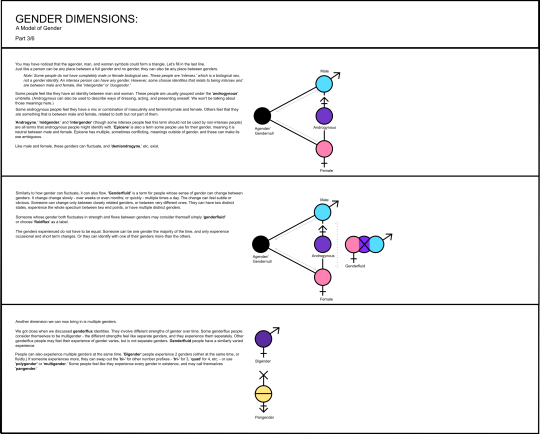
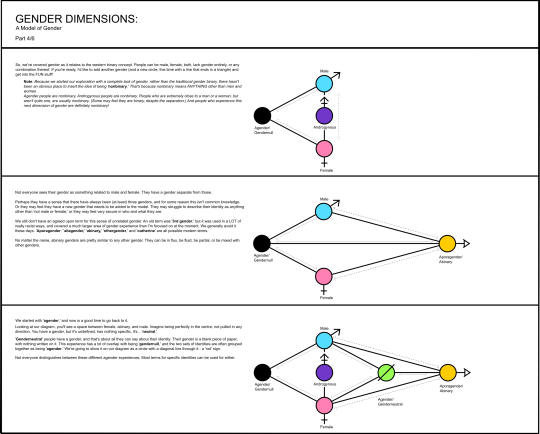


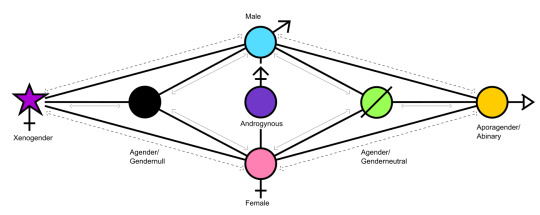
Made this in 2021, while trying to figure out this gender thing everyone was talking about. Organizing things is very helpful to me.
GENDER DIMENSIONS:
A Model of Gender
Part 1/6
Let's talk about gender.
You might have heard the phrase 'gender is a construct.' Today, we're going to take that literally. We're going to construct gender from the ground up.
Starting with nothing. This black circle has nothing in it. Some people have no gender. This is one of the meanings of 'agender.' (We'll get into the other meaning of agender later.) Another term is 'gendernull.' When asked to describe their gender, these people might say 'it isn't there,' that 'there's an empty space where gender is supposed to be,' or that 'they don't have much of that.'
Now let's add something! We'll add a white circle, and connect it to the black circle with a line. This dimension adds a sense of gender. It is not a specific type, but it is there! One way to describe having a gender is to say that you're 'allogender.' Usually, it's assumed that you have a gender, so this term isn't super common.
In the model of gender we're using, there are no binaries. (Okay, there is, but it's only there for a bit.) Gender doesn't have to be just there or not. People can have partial senses of gender. These are represented by the line in between our two circles.
The most common term for a partial sense of gender is 'demigender.' Any gender that isn't complete, but is there, can be considered a demigender.
Gender also doesn't need to be static in this model. It can fluctuate.
The term for a sense of gender that gets weaker and stronger is 'genderflux.' Some people go from no sense of gender, to full gender. Others fluctuate through a smaller part of the spectrum - agender to demigender, demigender to allogender, etc.
Part 2/6
Now lets add some of the genders that people can experience! For many people, their sense of gender is more specific then 'it exists/it doesn't exist'. The way of dividing up the 'it exists' area most familiar to Eurocentric cultures is into 'man' and 'woman.' This is called the 'gender binary'. (Told you we'd have a binary for a bit!) So we'll start by separating the gender circle into two circles - one with an arrow for 'man', and one with a cross for 'woman.'
You'll notice that we're adding here, not replacing. Man and woman are types of allogenders. All the previous things we discussed about sense of gender apply to them. Someone can be partially a man, mostly agender but slightly a woman, etc.
Western culture combines a lot of elements into the concepts 'male' and 'female.' These elements can be divided into some major categories, and are usually referred to as 'masculinity' and 'femininity'. Here are some things stereotypically associated with gender:
Biological Sex - what chromosomes you have. Also frequently applied to what your genitals look like, whether you have breasts, and things like facial hair.
Sexual Orientation - if you like boys, you must be a girl! If you're not attracted to breasts, you're not a real man! Drooling over a hunky actor is the sign that you're a woman instead of a girl! Men are expected to be attracted to women, and women to men.
Gender presentation - how deep is your voice? How long is your hair? How do move your hands while talking? How much space do you take up on the bus? How you look and take up space are expected to be tied to concepts of gender.
Gender dynamics - Women should support and nurture men. Men are expected to take the lead in mixed-gender conversations. Women are expected to share emotions with each other, while men should only talk about them with their wife. Expectations about how we act around our own and other genders are baked into concepts of gender.
Gender roles - Men should be in positions of authority. Women should do the household work. Men should be strong and successful. Women should be sexy. Gender comes with assumed responsibilities and limitations.
Gender identity - how you see and define yourself. For some people, this is mainly defined by the other elements. For others, it's an innate, separate sense.
This model is mostly about 'gender identity.' ('Orientation' comes up briefly in the discussion of 'xenogenders.') But all of the other elements can, and usually do, affect our sense of identity.
For some people, western concepts of gender have been imposed on their culture, and their relationship with western white culture affects their identity. If gender roles, dynamics, and presentation are different enough between cultures, they may become alienated from the western framework. Or they may have concepts of identity that don't exist in western cultures, and divide their models in very different ways than white people do.
For other people, one or more of the other gender elements are so uncomfortable that they struggle to, or can't, accept the identity that is usually combined with it. Maybe the gender roles they're expected to fit into feel painful. Maybe they can not understand gender dynamics and are frequently reprimanded. Maybe the rules of gender presentation are so stifling that they start to hate the identity itself.
Some people are able to reject these elements and keep their attachment to their gender. Other people find it easier to find a new gender identity, than to untangle the relationships between elements. They may talk about being 'male' but not 'masculine.' Or they may embrace 'femininity' but not consider themselves 'female.'
Part 3/6
You may have noticed that the agender, man, and woman symbols could form a triangle. Let's fill in the last line. Just like a person can be any place between a full gender and no gender, they can also be any place between genders.
Note: Some people do not have completely male or female biological sex. These people are 'intersex,' which is a biological sex, not a gender identity. An intersex person can have any gender. However, some choose identities that relate to being intersex and are between male and female, like 'intergender' or 'duogender.'
Some people feel like they have an identity between man and woman. These people are usually grouped under the 'androgynous' umbrella. (Androgynous can also be used to describe ways of dressing, acting, and presenting oneself. We won't be talking about those meanings here.)
Some androgynous people feel they have a mix or combination of masculinity and femininity/male and female. Others feel that they are something that is between male and female, related to both but not part of them.
Androgyne,' 'midgender,' and 'intergender' (though some intersex people feel this term should not be used by non-intersex people) are all terms that androgynous people might identify with. 'Epicene' is also a term some people use for their gender, meaning it is neutral between male and female. Epicene has multiple, sometimes conflicting, meanings outside of gender, and these can make its use ambiguous.
Like male and female, these genders can fluctuate, and 'demiandrogyne,' etc. exist.
Similarly to how gender can fluctuate, it can also flow. 'Genderfluid' is a term for people whose sense of gender can change between genders. It change change slowly - over weeks or even months; or quickly - multiple times a day. The change can feel subtle or obvious. Someone can change only between closely related genders, or between very different ones. They can have two distinct states, experience the whole spectrum between two end points, or have multiple distinct genders. Someone whose gender both fluctuates in strength and flows between genders may consider themself simply 'genderfluid' or choose 'fluidflux' as a label.
The genders experienced do not have to be equal. Someone can be one gender the majority of the time, and only experience occasional and short term changes. Or they can identify with one of their genders more than the others.
Another dimension we can now bring in is multiple genders.
We got close when we discussed genderflux identities. They involve different strengths of gender over time. Some genderflux people consider themselves to be multigender - the different strengths feel like separate genders, and they experience them separately. Other genderflux people may feel their experience of gender varies, but is not separate genders. Genderfluid people have a similarly varied experience.
People can also experience multiple genders at the same time. 'Bigender' people experience 2 genders (either at the same time, or fluidly.) If someone experiences more, they can swap out the 'bi-' for other number prefixes - 'tri-' for 3, 'quad' for 4, etc. - or use 'polygender' or 'multigender.' Some people feel like they experience every gender in existence, and may call themselves 'pangender.'
Part 4/6
So, we've covered gender as it relates to the western binary concept. People can be male, female, both, lack gender entirely, or any combination thereof. If you're ready, I'd like to add another gender (and a new circle, this time with a line that ends in a triangle) and get into the FUN stuff!
Note: Because we started our exploration with a complete lack of gender, rather than the traditional gender binary, there hasn't been an obvious place to insert the idea of being 'nonbinary.' That's because nonbinary means ANYTHING other than men and women. Agender people are nonbinary. Androgynous people are nonbinary. People who are extremely close to a man or a woman, but aren't quite one, are usually nonbinary. (Some may feel they are binary, despite the separation.) And people who experience this next dimension of gender are definitely nonbinary!
Not everyone sees their gender as something related to male and female. They have a gender separate from those.
Perhaps they have a sense that there have always been (at least) three genders, and for some reason this isn't common knowledge. Or they may feel they have a new gender that needs to be added to the model. They may struggle to describe their identity as anything other than 'not male or female,' or they may feel very secure in who and what they are.
We still don't have an agreed upon term for this sense of unrelated gender. An old term was '3rd gender,' but it was used in a LOT of really racist ways, and covered a much larger area of gender experience than I'm focused on at the moment. We generally avoid it these days. 'Aporagender,' 'aliagender,' 'abinary,' 'othergender,' and 'outherine' are all possible modern terms.
No matter the name, abinary genders are pretty similar to any other gender. They can be in flux, be fluid, be partial, or be mixed with other genders.
We started with 'agender,' and now is a good time to go back to it.
Looking at our diagram, you'll see a space between female, abinary, and male. Imagine being perfectly in the centre, not pulled in any direction. You have a gender, but it's undefined, has nothing specific, it's... 'neutral.'
Genderneutral' people have a gender, and that's about all they can say about their identity. Their gender is a blank piece of paper, with nothing written on it. This experience has a lot of overlap with being 'gendernull,' and the two sets of identities are often grouped together as being 'agender.' We're going to show it on our diagram as a circle with a diagonal line through it - a 'not' sign.
Not everyone distinguishes between these different agender experiences. Most terms for specific identities can be used for either.
Part 5/6
We have one final dimension in this model, and it's a big one!
Not everyone who experiences gender can describe it using gender concepts. Some gender isn't related to femininity or masculinity. It isn't a lack, a neutral feeling, or even a separate and distinct gendered feeling. Some people can only express their gender by relating it to non-gender concepts.
We use the term 'xenogender' to describe genders that incorporate non-gender elements. We'll show this dimension on our model as a purple star, instead of a circle, with a cross under it.
Some xenogenders can be grouped into larger categories, and we'll discuss some of those below.
Neurodivergence and mental illness can strongly affect how people experience the world. Some people feel their gender can not be disconnected from their brain make up. These genders are called 'neurogenders.'
For example:
Some autistic people struggle with social cues, and are unable to predict how a man or a woman will be expected to act in any given situation. They can grow up feeling very disconnected from gender, to the point that they may only identify as autistic, or consider their gender undefinable without also talking about their autism. A term they can use for themself is 'autigender.'
Some people dealing with PTSD feel that their gender was 'cut away' or damaged by the trauma they experienced. They might use the term 'caedogender' to describe their disconnected sense of gender.
Sexual and romantic orientation are related to gender in complex ways. Some people find that they cannot describe their gender without reference to their orientation. These are called 'orientationgenders.'
Someone who loves women, considers themself a butch lesbian, and has a complicated relationship with womanhood might call themself 'butchgender' or just 'butch.'
Someone who experiences no sexual attraction, and feels disconnected from a gender because of the sexual expectations people have of that gender, or the difficulty navigating gender roles without any interest in having a partner, may use the term 'acegender.'
Part 6/6
Some people feel their gender can only be described as an experience, or as similar to something else. These are called 'aesthetigenders' or 'noungenders.'
For example:
A person whose experience with gender feels like that of an alien interacting with something they don't understand might say that they're an 'alien' or 'aliengender.'
A person whose gender feels like energy, always shifting and moving, components understood and the whole hard to pin down, might describe it as 'energender.'
Someone who's spent years unable to describe themself, heard a certain song, and realized it encapsulated their experience perfectly, might use the name of the song to describe how their gender feels.
And that's our model!
Gender identity can be lacking, neutral, male, female, something else, or only able to be described in relation to a non-gender concept.
It can fluctuate in strength, flow between identities, or exist in multiple states at once.
It is related to, but not the same as, gender roles, dynamics, presentation, and orientation. It is also related to, but not the same as, biological sex. Maybe this discussion helped you find some structure in the mess that is gender. If it did, that's great! if not, that's fine too.
I'm not trying to say this is THE model of gender, or even that it is MY model. I created it as a way of synthesizing a lot of data that was hard for me to visualize and understand. I'm still working out my own point of view.
But if it makes things clearer for even one person, that would be wonderful. And if you have any insights, I'd love to hear them!
76 notes
·
View notes
Text

Gender-opposing
A label for when you view two of your genders as opposites. For example: being agender and genderfluid and viewing those gender experiences as extremely different or contrary.
This is obviously a self-imposed term because genders (like many concepts) don’t have exact opposites*. What one person experiences as opposites another person may experience as very similar.
Also, this term relates to viewing your personal genders as opposites. It should not be used to claim that genders you don’t use (especially abstract neogenders) are opposites or to go against the coiner’s wishes.
Like I view me being kenic and me being gendersilly as opposites, but there is no universally accepted opposite to either of those genders so I can’t just go around proclaiming that they're opposites for everyone else.
The flag's stripes go in opposite directions and also have 2 different themes (grays and bright colors). The gradient effects are for genders that the user views as "kind of" opposites. Flag ID in alt text.
*Disclaimer: this is different from antigender, and it is not in the leptrois system. Also, not all genders have ANTIN versions (see achiralgender).
54 notes
·
View notes
Text

Gender Buddy: Leptrois (22/120)
Level: 4 Element: Metal FRND: 54 PWR: 201
Abilities: Wiggle: A good way to burn off some extra energy when overstimulated. Conductivity: Using this with another Metal Buddy can create an electrical field for protection.
Bio: Sparks fly when this Buddy goes zooming by! How does it float? Magnetic power, of course. It loves to hoard nuts and bolts whenever it finds them, sometimes incorporating those pieces into its own body. Keep this thing away from light sockets and other Leptrois if you can!
10 notes
·
View notes
Text
hi. thanks for asking.
as far as I understand, those would be forms of interpreting what positive means. it could mean anything to the user. positive is contrasting with neutral and negative.
for nucleotrois, imagine this situation: (+1; 0). I imagine that if my gender is proxvir and not juxera, this would be euproxvir (positive) and nonjuxera (0).
however sometimes someone can only feel that a gender is present and some genders are absent or unknown whether present or not. they may not know whose or which. so nucleotrois would be useful for that.
no. not every leptrois identity is neutrois. for instance, I know someone who is exclusively positrois. they can be their own thing, yet they can mix with other genders.
also, my understanding may differ from other neutrois people. these interpretations may be seen as misrepresenting some people's experiences. so we acknowledge our experiences are not universal. each one is unique. but I hope our explanations will help people navigating these terms.
Hey @leptrois, what does "positive" mean for nucleotrois? It is this? That page says that positive as a quality is "multiplicity, addition, or excess of elements; it is a multiple, additive, or abundant gender, but it is not necessarily multigender." Is that what positive means for nucelotrois?
Also, are all leptrois genders considered neutrois? Like, are negatrois/positrois/electrois/nucleotrois all neutrois? Or their own thing?
2 notes
·
View notes
Text

Omnihilic: a personal gender coining!
[pt] Omnihilic: a personal gender coining! [end pt]
We've had this gender running around in our brain, metaphorically, for a good year or so now. Only today, on 4/22/25, did we name it! We hope you guys enjoy it, and yes this is quite grandiose to us but we're also dramatic as hell so XD



Omnihilic is a gender that is having so much gender that you don't have gender at all. We'd consider it an adjacent gender to isobug's Recursigender!

Word Meaning/Details
[pt] Word Meaning/Details [end pt]
"Omni-" is taken from Omnigender; we personally define the gender as "someone who experiences all genders but treats them all as one gender".
"-nihil" is a Latin word for nothing.
"-ic" is a suffix to tie it together meaning "like, of".
The symbol of Omnihilic is "∀" for all, and "{}" for empty set (aka nothing). ∀∅ could be an emojicode of sorts if you wanted it to be...for sillies! ∅ is the symbol for an empty set.
Note: I'll be honest, I feel like {∀} doesn't really make sense for the symbol…cause it's ({}) supposed to be empty and adding "∀" makes it…not that…whatever!! You hopefully get our point.)

Credit
[pt] Credit [end pt]
victomofrebellion for making Omnigender.
animatedglittergraphics-n-more for the top and bottom space dividers! The thinner black ones are mine, lol.
https://flag.rachel.systems/
photopea

Blinkies, Stamps, Userboxes, Userbars, Shiny Buttons, Pride Pixels, and dividers! :3c
[pt] Blinkies, Stamps, Userboxes, Userbars, Shiny Buttons, Pride Pixels, and dividers! :3c [end pt]
I used this stamp template, font used on stamps here, this userbox template, this userbar template, this pride pixel template, and the dividers were made by me fully.
Stamps


Userboxes






Userbar

Pride Pixel

Dividers



29 notes
·
View notes
Note
Anticomgender flag?

anticomgender [pt: anticomgender]

anticomgender : a gender defined as being the opposite of comgender.

Anticomgender flag :D I also added a definition for clarity.

↓ References: ✦ antigenders coining (by kgmps2) ✦ antiboy and antigirl flags (by @pridearchive) ✦ comgender coining and flag (by anon on pride-flags-for-us) ✦ alt comgender flag (by that-one-aroace-enby) ✦ edited comgender flag (by @isobug)

I used the second comgender flag listed on bug's post for the colours, and followed the antigender flag format.
So, the blues are from the opposite of the comgender yellows, the green opposite of pink/red, and orange opposite of blue, since it's anti-gender. The minus symbol uses a combination of the comgender colours. The center stripe is plain white, like in the antigender flags, instead of the comgender light grey, just because I prefer the higher contrast.
15 notes
·
View notes
Note
ambinary mesogender flag combo?

ambinary mesogender [pt: ambinary mesogender]

Ambinary and mesogender combo flag :]

↓ References: ✦ ambinary coining and flag (by @beyond-mogai-pride-flags / @arco-pluris) ✦ mesogender coining (by malcubus) ✦ mesogender flag (by @imoga-pride)

This is pretty simple, I just put all the original stripes together, pretty much exactly the same as the originals (slightly changed the ambinary dark blue colour, but that's it). The ambinary colours are on the outside, just for aesthetic reasons.
12 notes
·
View notes
Photo
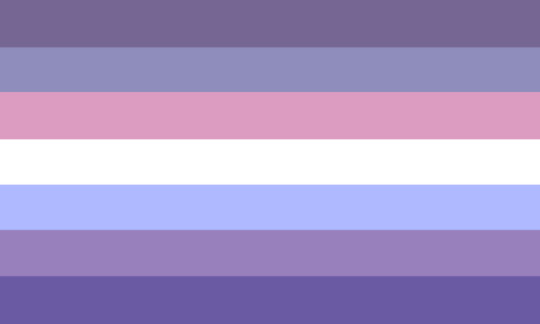
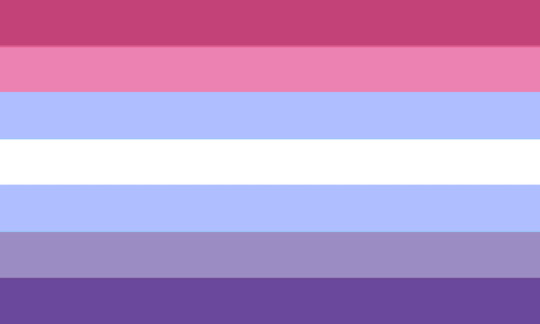
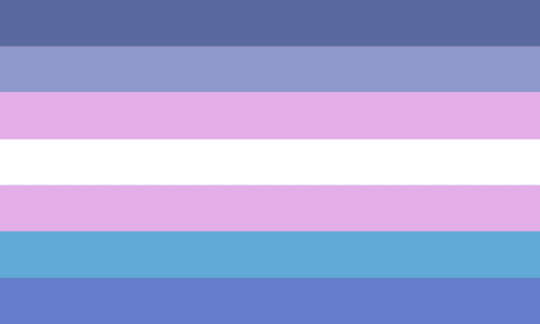
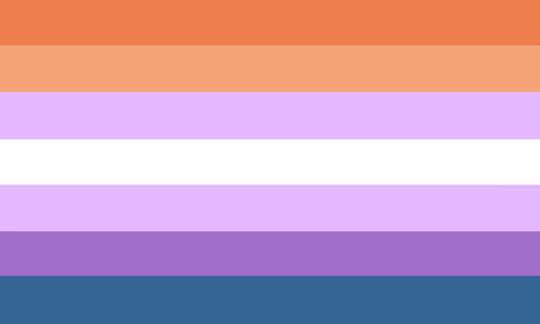
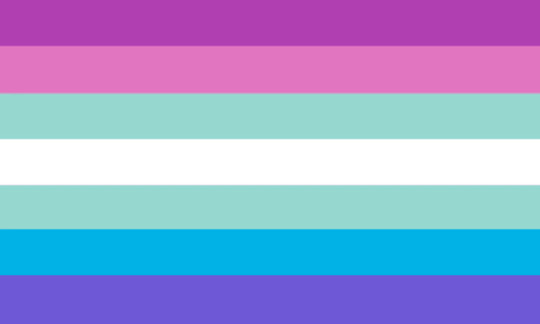
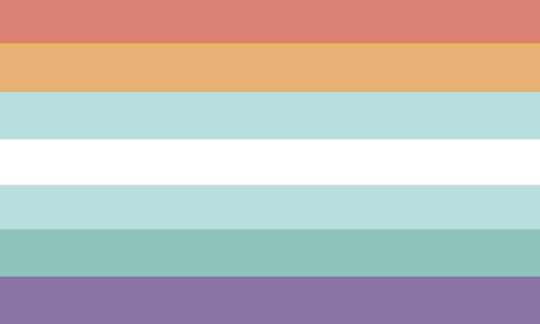
Some Bigender Flag Combos
Top: Demigirl/Demiboy or Demibigender, Transfem, Transmasc Bottom: Androgyne/Maverique, Androgyne/Neutrois, Maverique/Neutrois
53 notes
·
View notes
Text

Gravinous: Any non-neutral gender or quality. Gravinosity is the noun form.
Gravinous genders can include any non-neutral genders such as male, female, androgyne, maverique, ilyagender, péragender, xenine, and agender. Gravinous qualities would include masculine, feminine, androgynous, outherine, maverine, xenine, and null. Particular aporinities would apply here as well.
Gravinous comes from the Latin gravis meaning "heavy." It implies a strongly felt gender or a gender that leans toward or away from a given quality (as opposed to neutral, which is not meant to lean toward any specific quality and can often feel like it sits in the middle of genders or qualities.)
The name was inspired by this page on the Wiki Diversidades (Diversities Wiki in Portuguese.) The second line describes a spectrum of neutrality from neutrois to demineutrois/neutral to "saturated" gender. The use of "saturated" here is fascinating to me because in my brain, it denotes a sort of "weight" or "heaviness" to a gender. I wanted to encompass that idea in this term's naming.
The flag uses bold colors that don't represent anything specific, but pull away from the typical greens and yellows you might see in niaspec flags. It also does not include gray for the same reason. The "heaviness" of gravinosity is reflected in how dark and saturated a lot of the colors are, calling back to the Wiki Diversidades.
- 💙💚
18 notes
·
View notes
Text

Saturatrois or saturois (saturous, saturagender, saturigender, or saturogender): umbrella term for anyone who is not neutrois; or the polar opposite of neutrois.
#saturatrois#pride flags#lgbtqiapn+#noneutrois#nonneutrois#liomoqai#qtipal#q#qti#qit#itq#itnb#genders#non-neutrois#genero saturado#saturagender#saturogender#saturated gender#mogai#leptrois#saturois
8 notes
·
View notes
Text
when i have the energy i might coin apobinary…basic definition is that it’s not only nonbinary, but removed from the concept of binary itself (from the apogender = so agender that you’re removed from the concept of gender itself. i’m kinda that but a demi version, hence, apobinary)
6 notes
·
View notes
Text


flag id: a flag with 5 stripes, which are dark faded green, light green, near-black, golden yellow, and copper brown. end id.
banner id: a 1600x200 teal banner with the words ‘please read my dni before interacting. those on my / dni may still use my terms, so do not recoin them.’ in large white text in the center. the text takes up two lines, split at the slash. end id.
apobinary: not only being abinary or devoid of the gender binary, but entirely removed from the concept of the gender binary
[pt: apobinary: not only being abinary or devoid of the gender binary, but entirely removed from the concept of the gender binary. end pt]
a flag for apobinary, which was coined by anon! the flag is in a similar format to the apogender flag, with the inner black stripe representing removal from the binary and the rest of the stripes being adjusted from the inverted colors of this gender binary flag.
tags: @radiomogai, @liom-archive, @macchiane, @genderstarbucks, @sugar-and-vice-mogai
tags cont: @prettypinknarc, @skrimbliest
dni link
35 notes
·
View notes
Text
Gender Agnostic Pride Flag

Gender agnosticism: A term to describe an individual who considers the phenomenon of gender identity to be unknowable or indeterminable by its very nature; one who claims neither belief nor disbelief in gender as a concept; not experiencing identification nor disidentification with gender/as gendered.
Defined with help from @gender-resource. However, this description may not represent all gender agnostics and it’s up/open to them to use this flag regardless of their personal (un)definitions.
See also: gender nihilism, gender apathetic (apagender), quoigender, quesingender (quesin – questioning in nature), gender anarchy (gender anarchist/s). Not to be confused with gender atheism, which is used by TERFs (as gender antitheism, reframed of “anti-genderism”), nor with gender skepticism, which is close to the concept of transmedical exorsexism (“nb skeptic/al”) [but they can be redefined/taken back]. –Ap
90 notes
·
View notes